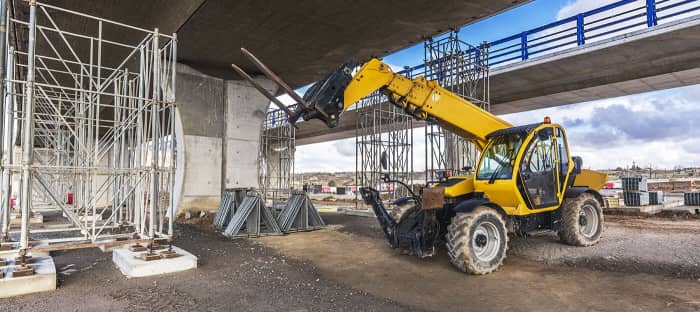Telehandler Reach Forklift Rentals
Telehandler Reach Forklift Rentals
Get pricing & availability from local rental companies:
Set Location for Rates
Set Location for Rates
Searching 8 Telehandler Reach Forklift rental sizes across rental companies.
5000 Lbs, 15 - 19 Ft Telehandler Reach Forklift
Daily (National Average):
$440
6000 Lbs, 32 - 39 Ft Telehandler Reach Forklift
Daily (National Average):
$533
6000 Lbs, 40 - 42 Ft Telehandler Reach Forklift
Daily (National Average):
$566
8000 Lbs, 41 - 43 Ft Telehandler Reach Forklift
Daily (National Average):
$595
10000 Lbs, 42 - 49 Ft Telehandler Reach Forklift
Daily (National Average):
$663
 If it’s available, DOZR finds it.We search all suppliers near you to source your equipment on-time for the right price.How DOZR Sources Equipment
If it’s available, DOZR finds it.We search all suppliers near you to source your equipment on-time for the right price.How DOZR Sources Equipment Flexible cancellation.In case you need to cancel your order, let us know as soon as possible to avoid cancellation fees.Cancellation Policy
Flexible cancellation.In case you need to cancel your order, let us know as soon as possible to avoid cancellation fees.Cancellation Policy We deliver your equipment where you need it, when you need.Simply set your delivery preferences in checkout and our team will handle the logistics.Delivery & Transportation
We deliver your equipment where you need it, when you need.Simply set your delivery preferences in checkout and our team will handle the logistics.Delivery & Transportation Equipment service.Breakdowns happen; we get you repairs or replacements fast to minimize downtime. The DOZR Team is available Mon–Fri between 8am and 5pm EST for any and all...Learn More
Equipment service.Breakdowns happen; we get you repairs or replacements fast to minimize downtime. The DOZR Team is available Mon–Fri between 8am and 5pm EST for any and all...Learn More Control your rentals with ease.After your order is placed, you can easily access and manage the rental, like extending and off-renting, right from the confirmation email.Managing Your Rental
Control your rentals with ease.After your order is placed, you can easily access and manage the rental, like extending and off-renting, right from the confirmation email.Managing Your Rental Need attachments?Buckets, thumbs, forks, augers – simply specify what you need in Checkout and The DOZR Team will make it happen.Attachments & Requests
Need attachments?Buckets, thumbs, forks, augers – simply specify what you need in Checkout and The DOZR Team will make it happen.Attachments & Requests More Questions?Our FAQ has answers.
More Questions?Our FAQ has answers.
10000 Lbs, 50 - 56 Ft Telehandler Reach Forklift
Daily (National Average):
$872
12000 Lbs, 55 - 56 Ft Telehandler Reach Forklift
Daily (National Average):
$849
15,000 Lbs, 44 - 56 Ft Telehandler Reach Forklift
Daily (National Average):
$1,029
Recommended Telehandler Reach Forklift Guides
The Ultimate Telehandler Spec Guide and Size Charts
Finding the right telehandler can be challenging. With this in-depth telehandler size and ...
Telehandler Weight & Spec Comparison ChartPicking the Right Equipment and Attachments for the Job | DOZR
Feeling stuck when deciding what equipment and attachments to rent for a job? Check this p...
Telehandler AttachmentsTelehandler vs. Boom Lift: What's the Difference?
Telehandler or boom lift? Understand the differences and choose the right equipment for yo...
Telehandler vs boom lift comparisonTelehandler Brand Comparison: Evaluating the Top Brands
Finding the right telehandler for the job can be difficult when there are so many brands t...
Compare The Best Telehandler BrandsSimilar Equipment
Learn More About Heavy Construction Equipment
Picking the Right Equipment and Attachments for the Job
Feeling stuck when deciding what equipment and attachments to rent for a job? Check this post out for a detailed description that will help you to nail your project with the right equipment and attachments every time.
Read Article
Boom Lifts vs Scissor Lifts: A Comprehensive Guide to Choosing the Right Aerial Lift for Your Project
For a comparison of working height, horizontal reach, maneuverability, and other factors, check out our boom lift and scissor lift comparison guide!
Read Article
How to Get the Most Out of Your Equipment Rental
Do you get the most of your equipment rental? Check out our tips and tricks for getting the most of your rental every time.
Read Article
8 Reasons to Rent
Looking to complete some heavy-duty work? Learn how to make a choice between the toughest design of renting or buying.
Read Article
Refund Policy
DOZR offers refunds within 24 hours if the equipment does not meet the specifications that were transacted on. Equipment rented on DOZR can be returned at any time by emailing equipment@dozr.com, and no further rental charges will be charged after the equipment is off-rented.
